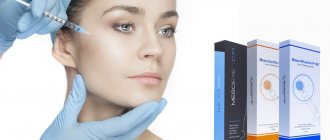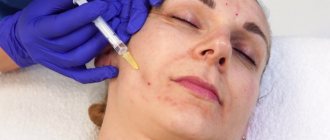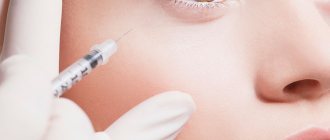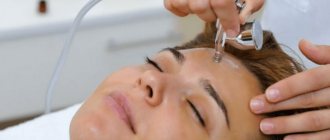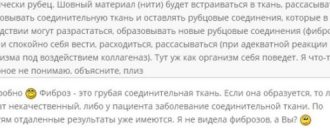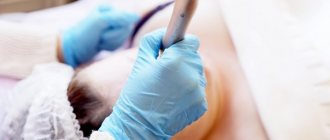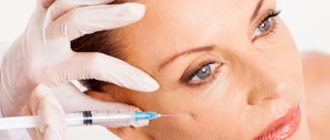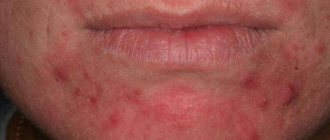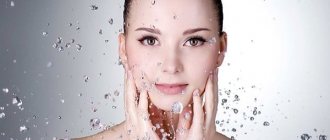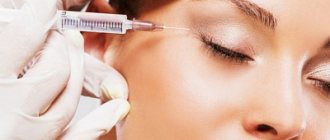Mesotherapy is a method of introducing drugs subcutaneously to a depth of 0.5-4 mm into the lesion site, carried out by injection, with the introduction of a microdose of a cocktail of drugs into each point.
The age at which it is recommended to start a course of mesotherapy is an individual milestone for each woman and depends on the general condition of the skin, however, we can say that for preventive purposes, mesotherapy courses can be carried out 1-2 times a year starting from 25 years.
The safety of the allopathic composition of drugs used for injection is also an individual indicator (see adverse reactions).
The importance of choosing a technique for administering drugs: using a syringe gun (mesoinjector), procedures are carried out to correct the body, i.e. denser skin, a syringe for mesotherapy is manually used to correct wrinkles on the face, as it allows you to more accurately introduce the drug into the right place, the active substances penetrate to the required depth in both cases and the likelihood of bruising depends not on the procedure technique but on the skin , the patient’s hormonal background (if the procedure is performed during menstruation, the likelihood of bruising increases).
Mesotherapy cannot be considered as an alternative to plastic surgery, but only as a complementary procedure. If a woman pays attention to her skin all the time, monitors its condition and from the age of about 25-30 years begins to conduct periodic mesotherapy sessions, then it is possible to “delay” the time when she will need the intervention of a plastic surgeon for a considerable period.
In approximately 80% of cases, patients at our clinic experience a visible inhibition of the aging process.
What is mesotherapy, types of mesotherapy
Mesotherapy is a technique for introducing various “cocktails” (combinations of certain biological substances) under the skin. Why is it better to have mesotherapy done by a cosmetologist than to use only home care products? The fact is that various creams, ointments, serums, etc., which are intended for home care, are intended to maintain skin condition. All cosmetic products for home care only affect the surface layers of the skin. And mesotherapy is based on the introduction of drugs into the middle layers (under the skin), which helps the drug “from the inside” to affect the problem.
Drugs that are injected under the skin may contain a completely different set of enzymes, vitamins, plant extracts and hormones. The cosmetologist selects the drug that is needed specifically for your skin.
This procedure comes in several types:
- injection mesotherapy;
- hardware injection mesotherapy;
- fractional mesotherapy (hardware microneedling);
- non-injection mesotherapy Dermadrop.
Methods for performing the procedure
The effectiveness of mesotherapy for the face, body and hair depends on the optimal combination of the effectiveness of the drug itself and the technique used for its administration. Drugs can be injected under the skin manually using a syringe or using special mesoinjector devices, named “Pistor gun” in honor of the founder of mesotherapy. With their help, a strictly measured dose of the drug is injected into the skin, which not only shortens the duration of the procedure, but also makes it less painful, especially when it comes to a large treatment area - for example, when correcting signs of cellulite.
You can buy preparations and cocktails for mesotherapy of hair, face and body from Martinex. A wide selection of products from the best manufacturers at the best prices.
Mesotherapy training for cosmetologists at the Martinex educational center.
What is good about mesotherapy? Benefits of mesotherapy
It’s not for nothing that this procedure has gained such popularity. Mesotherapy has some advantages compared to some other methods of treating skin diseases:
- safety
(risks are minimal due to the fact that the drugs administered to the patient are certified); - effectiveness
(a correctly selected drug will give a pronounced effect, which after completing the course can last for more than a year); - painlessness
(some types of procedures, for example, non-injection mesotherapy using the Dermadrop device are absolutely painless); - no age restrictions
(due to the variety of drugs administered, mesotherapy will help improve skin condition for people of any age).
Facial mesotherapy
Most often, this technique is used in facial cosmetology. After all, well-groomed facial skin that looks smooth, healthy and glowing always looks attractive. Unfortunately, a person at different stages of life has its own problems:
- during adolescence, most people try to get rid of acne
; - , scars and post-acne, dark circles under the eyes, rosacea, excessive dullness and dry skin
may bother you ; - After 30 years, age-related changes usually begin to occur, for example, loss of elasticity and the appearance of the first wrinkles
.
When you come to an appointment with a cosmetologist, you need to tell about all the facial skin problems that bother you. In this case, a specialist will be able to choose a suitable cocktail for you that can solve all your skin problems.
Types of mesotherapy
For each problem there is its own method of facial mesotherapy and a special cocktail is selected. Based on the functional purpose and method of administration to the skin, the following types of therapy are distinguished:
- Mesolifting . Correction of age-related skin changes - photoaging and chronoaging. The injected drugs regulate the cellular functions of the dermis and epidermis, improve blood circulation, relieve inflammation, tighten the skin (lifting effect)
- Vitomesotherapy . Introduction of drugs rich in vitamins, minerals and antioxidants. It is also used in complex anti-aging therapy, anti-age, promoting revitalization and nutrition, preventing age-related changes in young patients
- Hydromesotherapy . Another anti-age mesotherapy procedure restores water balance, has an anti-inflammatory and wound-healing effect, promotes rapid skin regeneration, stimulates fibroblast activity
- Neuromesotherapy . Muscle relaxant effect on facial muscles - correction of their excessive activity. Can be used as an alternative to Botox injections. Eliminates fine wrinkles, corrects deep ones, restores the oval shape of the face, neck and décolleté
- Biorevitalization . Correction of wrinkles. Improving skin turgor and elasticity, natural restoration of the functional activity of fibroblasts, stimulation of microcirculation and enhancing the antioxidant activity of skin cells
Eye mesotherapy (in the area under the eyes)
It's no secret that the skin in the area around the eyes is sensitive and delicate. This part of the face needs special careful care, which will give a strong effect. Mesotherapy is one of the popular methods of gentle care for the skin around the eyes. It allows you to gently and without complications increase skin tone and activate cell renewal processes. In addition, various clinical studies have proven the high effectiveness of mesotherapy in combating age-related changes in the skin around the eyes.
Mesotherapy in the combined correction of age-related changes in the face in patients over 45 years old
Patients 45 years of age and older are an audience very interested in correcting involutional changes in the skin of the face and neck. However, doctors often diagnose them with concomitant aesthetic, dermatological, somatic and other problems, which either complicate or completely eliminate the use of one or another technique. What is the algorithm for working with such patients? In what situations should a cosmetologist enlist the support of specialized specialists, and when can he cope with the task himself, slightly modifying the procedure protocol? Why in some cases does preparation for procedures and a properly structured recovery period play a dominant role in achieving the best aesthetic effect?
Aesthetic mesotherapy affects the quality of the skin without affecting the underlying tissue. In what cases can it be considered a method of choice, and when does it play an important but secondary role, if we are talking about patients in the older age group?
A review of the literature, many years of clinical experience and a generalized analysis of the reasons for success and failure in therapeutic cosmetology allow us to say with confidence that the tactics of managing patients 45 years of age and older is based on a deep pathogenetic understanding of the biological processes occurring in the body of women who have entered the period of perimenopause and menopause and postmenopause. Since the skin is an important indicator, estrogen-sensitive and reactive organ, in the group under consideration, changes in the skin will be associated with thinning of the epidermis and dermis, a qualitative and quantitative decrease in the content of its functional structures. In the process of restructuring the body, fibroblasts, the main cells of the dermis with high synthetic activity, are primarily susceptible to atrophic changes, which affects the quality and quantity of the endogenous components of the skin they produce - hyaluronic acid and collagen. However, the process of age-related involution affects not only the epidermis and dermis, but also the subcutaneous fatty tissue, muscles and osteochondral structures of the face. Taking into account the full depth of the described structural and functional changes, choosing any of the existing methods of therapeutic cosmetology as a mono-effect without taking into account an individual assessment of facial architectonics, morphological type and degree of aging will be ineffective. For example, the appointment of aesthetic mesotherapy, the action of which is aimed only at improving the qualitative characteristics (color, moisture, tone, microrelief) of the epidermis and dermis, as a monomethod in patients with a deforming type of aging and severe gravitational ptosis may not give a visible result that satisfies the patient, and a doctor. Thus, the therapeutic strategy for managing patients 45 years of age and older most often involves the appointment of a combined protocol - its construction is based on knowledge of algorithms for combining various methods of aesthetic correction of age-related changes. Today, this approach is called aesthetic geroprotection, the tasks of which are not limited only to complex, layer-by-layer and stage-by-stage effects on all tissues affected during the aging process of the face and neck, but also imply close interaction between a dermatologist and cosmetologist with other specialists: therapist, endocrinologist, gynecologist , dentist, surgeon. In order to avoid misunderstandings in the doctor-patient tandem, when choosing an algorithm for aesthetic geroprotection and determining the sequence of inclusion of mesotherapy procedures in it, the dermatologist-cosmetologist must carefully compare the medical history data and the results of the clinical examination of a particular patient.
Collection of information about the patient using various research methods Anamnestic
- Hereditary history (genetic predisposition to the appearance of early age-related changes)
- Somatic anamnesis (chronic somatic diseases in the stage of decompensation, oncological diseases, metabolic diseases)
- Allergy history (drug, food, household allergies)
- Permanent or transient use of medications
- Methods of previous aesthetic therapy, specifying the age at which they were prescribed
- Lifestyle
- Professional route
- Discipline
- Readiness for injection techniques
- Reality of expectations and readiness for certain material costs
Objective clinical examination
- State of health at the time of visiting the doctor
- Constitutional skin type
- Phototype
- Aging type
- Severity of problems at the time of visiting a doctor
- Individual threshold of pain sensitivity
- Psychotype (stable, labile)
Clinical and photo-documentary monitoring
- Dynamics of skin condition
Important conditions for success are: clarifying the patient’s wishes, concerns and expectations; detailed discussion of the treatment plan and sequence of procedures; providing the patient with detailed information about the methods and drugs that are planned for use during the course of aesthetic therapy; discussion of the terms of rehabilitation after a particular procedure; filling out an outpatient card and informed consent. To objectively assess the patient’s condition and predict the outcome, it is necessary to conduct photo-documentary monitoring before and after completion of the course of therapy. This approach, taking into account established contraindications, will allow the doctor to determine the range of possible procedures and develop an individual algorithm for aesthetic geroprotection. What place will aesthetic mesotherapy take in the proposed algorithm? Will it be the main or additional method in the combination protocol? All this will depend on the patient’s complaints (request) and the presence of concomitant somatic and aesthetic problems that require prior consultation with another specialist or correction by other methods. For example, in case of pronounced rosacea, aesthetic mesotherapy with the aim of strengthening the vascular wall is prescribed only as the final method in a combined protocol. The priority treatment methods in such a clinical situation will be laser technologies. In addition, it is necessary to remember that patients with diffuse forms of rosacea require consultation with a phlebologist to check the condition of the vascular bed of the body as a whole, and an endocrinologist to exclude diabetes mellitus. The second important criterion when determining the place and sequence of mesotherapy in a combined aesthetic geroprotection protocol is the objective clinical status, taking into account the morphological type of aging and the severity of age-related changes (I-IV).
Fine-wrinkled type of aging In such patients, the skin is thin, sensitive, often dry, subcutaneous fatty tissue is poorly expressed. Wrinkles, folds and creases can be present in different quantities and have varying degrees of severity: from single to multiple, from small to deep. Characterized by focal disorders of skin pigmentation such as hyperchromia. Muscle tone is slightly reduced, ptosis of the soft tissues of the face is mild. The main complaint of such patients will be a deterioration in the quality of the skin: its color, tone, elasticity, moisture. An objective examination reveals changes affecting mainly the epidermis and dermis. For this category of patients, mesotherapy can be considered the method of choice and prescribed as the first step in the treatment protocol of combination therapy. The choice of the group of mesotherapy drug, the priority technique of its administration and the duration of the course depends on the clinical problem being solved, the somatic and allergic history of the patient. Mesotherapy programs will allow you to quickly moisturize the superficial and deep layers of the skin, restore its barrier properties, improve metabolic processes and cellular metabolic reactions, increase the synthetic activity of fibroblasts, and activate the physiological regeneration of the skin.
Comparative characteristics of groups of mesotherapy drugs
Classic mesotherapy preparations
- Mono- and multicomponent (2 or more components) solutions, ready-made or ex tempore cocktails
- Unstabilized HA, which is part of the classic meso cocktail, has a low concentration (less than 10 mg/ml) and low molecular weight (< 1000 kDa)
- Biodegrades within 1 week
- Classic scheme of intensive course of therapy once every 7-10 days No. 7-10
- Basic injection techniques: nappage, papule
Classic biorevitalizants
- Monocomponent gels or thick solutions based on unstabilized HA
- HA concentration from 10 mg/ml and higher with high molecular weight (>1000 kDa)
- Biodegrades within 2 weeks
- Classic intensive course of therapy: once every 2 weeks No. 2-4
- Basic injection techniques: papule, linear retrograde
Long-lasting biorevitalizants
- Monocomponent thick gels based on unstabilized high molecular weight HA (>2000 kDa), in high concentration (>12 mg/mg)
- They include osmolar components (glycerol, mannitol, sorbitol), which inhibit the biodegradation of HA and enhance its properties.
- Biodegrades within 3-4 weeks
- Classic intensive course of therapy: once every 4 weeks No. 3
- Basic injection techniques: micropapule, deep papule, linear retrograde
Polyrevitalizants (multicomponent biorevitalizants, bioreparants)
- Multicomponent preparations in the form of a gel or thick solution, which in addition to HA include vitamins, trace elements, minerals, amino acids, nucleic acids, coenzymes, etc.
- Unstabilized HA, which is part of polyrevitalizant, has a high concentration (10 mg/ml or more) and high molecular weight (>1000 kDa)
- Biodegrades within 3 weeks
- Classic scheme of intensive course of therapy once every 3-4 weeks No. 3-5
- Basic injection techniques: micropapule, deep papule, linear retrograde
Cytoplasmic drugs (biomolecular drugs, organopreparations)
- Highly purified extracts (solutions) from animal organs and tissues of varying degrees of maturity
- Contains the biomolecular mass of the cell cytoplasm. They have a complex multicomponent composition
- Biodegrades within 1-2 weeks
- Classic scheme of intensive course of therapy once every 10-14 days No. 5-7
- Basic injection techniques: nappage, micropapule
In the future, the combined protocol can be expanded with procedures aimed at smoothing the skin microrelief (for example, using medium chemical peeling, cosmechanics, cryotherapy, light therapy, laser ablation technologies, phototherapy, microdermabrasion, etc.). At the final stage of therapy, if necessary, injection plastic procedures can be prescribed to recreate the delicate volume of facial tissue and targeted correction of wrinkles, folds and creases using preparations based on stabilized hyaluronic acid. Also, according to indications, aesthetic botulinum therapy can be performed.
Clinical example Patient B., 47 years old. She complained of decreased tone and increased dryness of the skin, the appearance of superficial wrinkles in the periorbital and perioral areas, loss of volume of facial tissue in the infraorbital and zygomatic areas. The menstrual cycle is regular (perimenopause). Allergy history is calm. There are no absolute somatic contraindications for cosmetic procedures. Objective status: the skin of the face and neck is thin, dry, uneven in color, with signs of focal hyperpigmentation, decreased tone. Moderately pronounced wrinkles above the upper lip, in the periorbital and buccal areas. Subcutaneous fatty tissue is poorly developed. There is a decrease in volume and age-related deformation of fat packets in the infraorbital and zygomatic areas, and retraction of the nasolabial triangle. The facial muscles are thin, flat, tone is preserved. Diagnosis: natural aging of the face and neck according to the fine-wrinkled type. Lipoatrophy of the nasolabial, infraorbital, zygomatic areas of the I-II degree (photo 1).
Photo 1. Patient B., 47 years old. Natural aging of the face and neck according to the fine-wrinkled type. Lipoatrophy of the nasolabial, infraorbital, zygomatic areas of the I-II degree.
Photo 2. The same patient after a course of aesthetic geroprotection. A significant improvement in appearance was noted.
Patient management tactics
First stage. To improve skin quality, a mesotherapy method has been proposed. For the intensive protocol, two groups of mesotherapy drugs were selected - multicomponent and prolonged biorevitalizants. 3 polyrevitalization procedures were performed once every 3 weeks and 2 prolonged biorevitalization procedures once a month. The total number of procedures is 5. At the third procedure, the patient saw a significant improvement in the quality of the skin of the face and neck (the skin became smooth, moisturized, the feeling of tightness disappeared, and the color improved).
Second phase. To recreate the delicate volume of tissue in the zygomatic, infraorbital, nasolabial and lip areas, injection modeling was performed using preparations based on stabilized hyaluronic acid of varying densities.
Third stage. To partially limit dynamic activity and level out fine static wrinkles in the area between the eyebrows and dynamic wrinkles in the lateral parts of the periorbital areas (“crow’s feet”), aesthetic botulinum therapy was performed using medium therapeutic dosages of BTA.
Result. Significant improvement in appearance (photo 2). The patient was transferred to supportive professional external care procedures. It is recommended to repeat the mesotherapy protocol in the same volume after 6 months.
When working with patients aged 45+, in whom involutional changes affect not only the epidermis and dermis, but also deeper structures of the face, prescribing mesotherapy as a monomethod is often insufficient. The situation can be aggravated by an illiterate choice of drugs. At best, this will not meet the patient’s expectations, at worst, it will discredit mesotherapy as a method.
Deforming type of aging In such patients, the skin is predominantly dense, subcutaneous fatty tissue and facial muscles are developed. During the aging process, tissue tone decreases, ptosis of the muscles and facial skin progresses, and subcutaneous fat tissue is redistributed. Severe sagging appears, especially in the lower third of the face, while there may be very few wrinkles. Such a person is prone to lymphostasis, edema, and rosacea. Patients look youthful for a long time, but with the onset of menopause they age sharply. The main complaint will be a change in the oval of the face: the appearance of “springs”, a hernia in the eyelid area, disruption of the facial relief and the appearance of recesses in the infraorbital, zygomatic, nasolabial and labiomental areas. An objective examination reveals changes that are predominantly characterized by gravitational displacement and atrophic changes in subcutaneous fat, decreased skin and muscle tone, and symptoms of lymphostasis. In patients with this morphological type of aging, mesotherapy is far from the first place in the complex of therapeutic measures. When choosing a combination of therapy methods, it is necessary to determine the severity of involutional changes.
If the signs of facial aging are mild or moderate (degree I-II), then at the first stage the main focus of therapy is active lymphatic drainage of facial tissues (for example, contact local cryotherapy, cosmechanics, microcurrent, vacuum drainage, etc.). At the second stage, hardware lifting (for example, cryolifting, microcurrent therapy, myostimulation, etc.) will be required to restore muscle tone. The third stage will be aimed at recreating the volume of subcutaneous fatty tissue of the face in areas with obvious atrophy. To solve this problem, you can choose injection plastic procedures (for example, volume modeling with fillers based on stabilized hyaluronic acid, lipofilling, etc.). At the fourth stage, alternating mesotherapy procedures with chemical, mechanical or laser ablations is effective to level the microrelief and improve the quality characteristics of the skin. At the end of the course, you can perform aesthetic botulinum therapy. In case of pronounced changes (III-IV degree), surgical correction should be recommended at the consultation stage. If for some reason (somatic contraindications, patient’s reluctance, etc.) surgical treatment methods are not considered, then a combined therapeutic correction program is built. At the same time, it is important to debunk the patient’s high expectations, inform her in detail about the duration of the course of combination therapy, the regularity and phasing of the procedures, and possible material costs. At the end of the consultation, it is necessary to voice the expected prognosis of aesthetic geroprotection.
Clinical example Patient N., 60 years old. She complained of sagging facial tissues, emphasized nasolabial and labio-mental folds, changes in the oval of the face in the form of “bulldog cheeks,” and the appearance of furrows in the naso-zygomatic areas. Persistent wrinkles in the forehead and between the eyebrows, wrinkles in the lateral part of the orbits, significantly intensifying when the patient smiles. The patient is in the period of persistent postmenopause. Allergy history is calm. There are no absolute somatic contraindications for cosmetic procedures. Consulted with a gynecologist and endocrinologist. Receives hormone replacement therapy.
Today, an integrated approach to involutional changes in the skin of the face and neck is called aesthetic geroprotection. Its tasks are not limited to a complex, layer-by-layer and step-by-step effect on all tissues affected by the aging process, but also imply close interaction between a dermatologist-cosmetologist and other specialists: therapist, endocrinologist, gynecologist, dentist, surgeon.
She is not considering plastic surgery for herself. The only option that does not exclude in the future is blepharoplasty. Objective status: in the upper third of the face there are static wrinkles in the forehead and between the eyebrows, ptosis of the lateral eyebrows, excess skin of the upper and lower eyelids. Facial tissues are swollen and pasty. Gravitational changes in facial tissues in the middle and lower thirds are pronounced and are characterized by deformation of the contours of the zygomatic and infraorbital areas; bilateral protrusion of paint bags; the presence of emphasized naso-zygomatic grooves and nasolabial folds; atrophy of subcutaneous fatty tissue in the labio-mental area, changes in the oval of the face. Also, upon examination, single vertical static purse-string wrinkles were revealed in the perioral area above, and loss of volume in the tissues of the upper lip. Diagnosis: natural aging of the face according to the deforming type. Hypertonic type of muscle activity, static wrinkles of the upper third of the face. Moderately pronounced gravitational ptosis of facial tissues, hernias of the upper and lower eyelids, a tendency to edema. Lipoatrophy of the infraorbital, nasolabial and labiomental areas of the II degree (photo 3) .
Photo 3. Patient N., 60 years old. Natural aging of the face according to the deforming type. Hypertonic type of muscle activity, static wrinkles of the upper third of the face. Moderately pronounced gravitational ptosis of facial tissues, hernias of the upper and lower eyelids, a tendency to edema. Lipoatrophy of the infraorbital, nasolabial and labiomental areas, degree II.
Photo 4. The same patient after staged aesthetic geroprotection. A significant improvement in appearance was noted.
Patient management tactics
First stage. To relieve swelling, drain tissue and increase muscle tone, a course of hardware contact cryodrainage and cryolifting was prescribed: 2 procedures per week, the total number of procedures is 10.
Second phase. To recreate the volume of tissue in the infraorbital, nasolabial, labiomental and lip areas, injection modeling was performed using preparations based on stabilized hyaluronic acid of various densities.
Third stage. To improve skin color and tone, 5 mesotherapy procedures were carried out - the first two using cytoplasmic group drugs once every 2 weeks, the next three once every 2 weeks with the prescription of multi-component mesotherapy solutions with a small content of hyaluronic acid. Each mesotherapy procedure was completed with photolight therapy. After the third stage, the patient noted a significant improvement in the appearance of her face in general and the quality of her skin in particular. The complexion has improved, swelling and the appearance of fine wrinkles on the lower eyelid have decreased. Gone was the tired look.
Fourth stage. To correct static wrinkles in the forehead, between the eyebrows and in the lateral periorbital region, aesthetic botulinum therapy was performed using medium therapeutic dosages of BTA.
Result. Significant improvement in appearance (photo 4) . The patient was transferred to supportive professional external care procedures. A dynamic examination after 6 months is recommended to determine further therapeutic management tactics.
Mixed type of aging Combines certain clinical signs of previous types of aging. Upon examination, the following are revealed: moderately dense skin, moderately developed subcutaneous fatty tissue, moderately developed muscles. Depending on the patient’s complaints and objective examination data, the doctor builds an individual correction program. For some, a mesotherapy protocol should be offered first to improve skin quality; for some - hardware methods; For some, alternate injection and hardware methods. And at the end of the course, according to indications, carry out injection modeling of areas of lipoatrophy in various anatomical areas and aesthetic botulinum therapy.
Clinical example Patient S., 56 years old. She complained of increased dryness and sagging skin, “gray” complexion; severe swelling in the lower eyelids, mainly in the morning; loss of volume of facial tissue in the infraorbital and buccal areas, “recession” of the chin. The patient is in menopause. Professional activity is associated with frequent changes in climate zones. He has smoked 1 pack of cigarettes a day for 30 years. Allergy of the type of acute urticaria to vitamins C, B3, B6 and B 12, antibiotics of the penicillin group. There are no absolute somatic contraindications for cosmetic procedures. Consulted with a gynecologist and endocrinologist. Receives hormone replacement therapy. Two years earlier, she took courses in hardware techniques related to tissue heating and received BTA injections. According to the patient, she does not consider the result of the correction to be satisfactory, since after the course of hardware procedures, the dryness and sensitivity of the skin increased, the tone and color were not restored. After BTA injections, I suffered from severe headaches and a gloomy expression on my face. The possibility of surgical correction is not considered. Objective status: the skin is dry, dull, tone is sharply reduced. In the upper third of the face, there is hypertonicity of the frontal muscle, static wrinkles in the forehead and between the eyebrows, ptosis of the lateral eyebrows, excess skin and hernias of the lower eyelids. Deformation of the contours of the zygomatic, infraorbital, buccal and labiomental areas. Emphasized palpebromal and nasojugal grooves. Moderately pronounced paint bags. Sagging tissue in the lower third of the face. Diagnosis: natural facial aging of mixed type. Hypertonic type of muscle activity, static wrinkles of the upper third of the face, ptosis of the lateral eyebrows, hernias of the lower eyelids. Gravitational ptosis of facial tissues and lipoatrophy of the infraorbital, zygomatic, buccal and labiomental areas, grades I-III (photo 5).
Photo. 5. Patient S., 56 years old. Natural aging of the face according to the mixed type. Hypertonic type of muscle activity, static wrinkles of the upper third of the face, ptosis of the lateral sections of the eyebrows, hernias of the lower eyelids. Gravitational ptosis of facial tissues or poatrophy of the infraorbital, power, buccal and labiomental areas of II-III degree.
Photo. 6. The same patient after staged aesthetic geroprotection. A significant improvement in appearance was noted.
Patient management tactics
First stage. To restore the relief and contours of the face, volumetric modeling of the middle and lower third of the face was performed with super-dense fillers based on stabilized hyaluronic acid.
Second phase. To improve the quality characteristics of the skin (color, moisture, tone), an intensive course of mesotherapy was carried out, alternating between different groups of mesotherapy drugs: cytoplasmic therapy + classic biorevitalizants - 3 procedures, once every 14 days; Then the patient was transferred to a group of prolonged biorevitalizants - 3 procedures, once a month. The total number of procedures in the intensive course of mesotherapy is 6. After the third procedure, the patient noted that the skin became smoother, more moisturized, less dry and sensitive, and her complexion improved.
Third stage. Nuanced modeling of the lateral sections of the eyebrows and the area of the nasolabial triangle with fillers based on stabilized medium-density hyaluronic acid.
Result. Significant improvement in appearance (photo 6) . The patient was transferred to a maintenance mesotherapy protocol using the same groups of drugs once every 3 months with the constant use of professional skin care products at home. After a year, it is recommended to repeat volumetric facial modeling. In conclusion, I would like to note that mesotherapy still remains the most effective technique that fully restores lost tone, elasticity, skin moisture, color and microrelief. However, when working with patients aged 45+, in whom involutional changes affect not only the epidermis and dermis, but also deeper structures of the face, prescribing this method as monotherapy is often insufficient. The situation can be aggravated by an illiterate choice of a group of mesotherapy drugs. At best, this will not meet the patient’s expectations; at worst, it will discredit mesotherapy as a method. Systematized clinical thinking, knowledge of a wide arsenal of methods and means of anti-aging correction, developed aesthetic taste will allow the cosmetologist to choose individual combined protocols for aesthetic geroprotection, where for some patients mesotherapy will be the basic method of therapy, for others it will be an important additional method in a comprehensive program for the correction of age-related changes facial tissues. This approach to working with the group of 45 years and older will increase patient satisfaction with the results of procedures and the degree of confidence in the doctor’s professionalism.
| POSSIBLE CONTRAINDICATIONS CONSULTATION WITH A SPECIALIST IS REQUIRED Specialists do not provide consultations over the phone, you must make an appointment for a consultation. | Place an order Ask a question |
What is better: mesotherapy or biorevitalization?
Mesotherapy and biorevitalization are procedures that use different drugs. In mesotherapy, various cocktails are used, which may contain hyaluronic acid, as well as other vitamins and substances. And the preparations for biorevitalization contain only a solution of hyaluronic acid.
If you want to get instant results, then you should give preference to biorevitalization. And if your goal is healthy, moisturized and nourished skin, then it is better to choose mesotherapy.
Carrying out the procedure
The main principles of the procedure are that the injections are made shallowly, in small doses and rarely.
Vitamins, minerals, nucleic acids and amino acids, homeopathic extracts and extracts are injected into special points on the face with the finest needle. All these nutrients and tonics become “building material” for connective and nervous tissue. For example, a mixture of hyaluronic acid, collagen and moisturizing components works great with expression wrinkles. And against age wrinkles, cell extracts of natural origin are used.
To carry out the procedure, the doctor chooses a manual or hardware method of introducing the anti-aging composition. The manual method is injections with a regular syringe, but with a very thin needle. The peculiarity of the method is that the doctor controls the depth of needle insertion depending on the characteristics of the skin. The hardware method is injection using an electronic or mechanical gun. It is characterized by almost absolute painlessness. The number of injections depends on the final goal of facial mesotherapy and the area of the skin surface being treated. Despite the fact that the thinnest needle is used during the procedure, the cosmetologist applies an anesthetic cream to the face to minimize discomfort as much as possible. An antiseptic is also used to prevent inflammatory processes. Immediately after the injection session, the skin may become swollen and red. Sometimes tiny puncture marks may be visible. All these manifestations are temporary and disappear within a few hours. Also, on the first day you should not wash your face, apply cosmetics to your face, or touch your face with your hands. Our doctors prescribe special care products that will help the skin recover faster after the session.
Non-injection facial mesotherapy - Dermadrop device
Non-invasive (no punctures) technique is an excellent alternative to injection. It is mesotherapy with the Dermadrop device that allows you to get the same effects, but at the same time any contraindications are excluded.
Advantages of this method:
- the result is visible after 1 procedure;
- absolutely no pain (after all, the drug penetrates into the deep layers of the skin under the influence of supersonic oxygen pressure);
- there are no contraindications for pregnant women (this procedure does not involve injections, so stress for expectant mothers is excluded).

